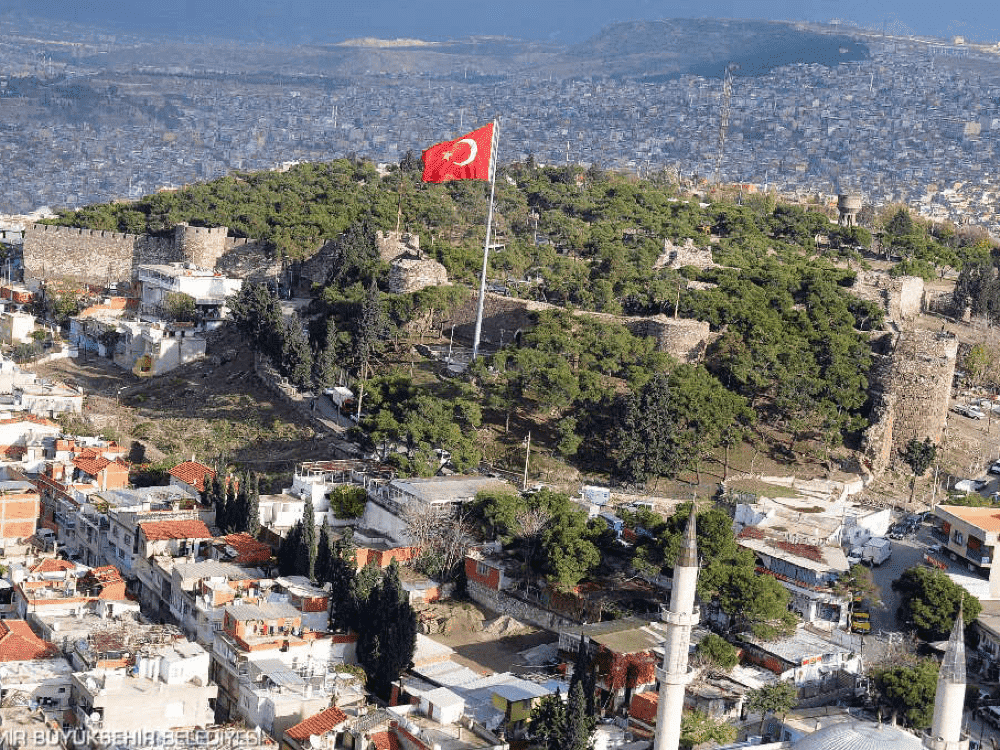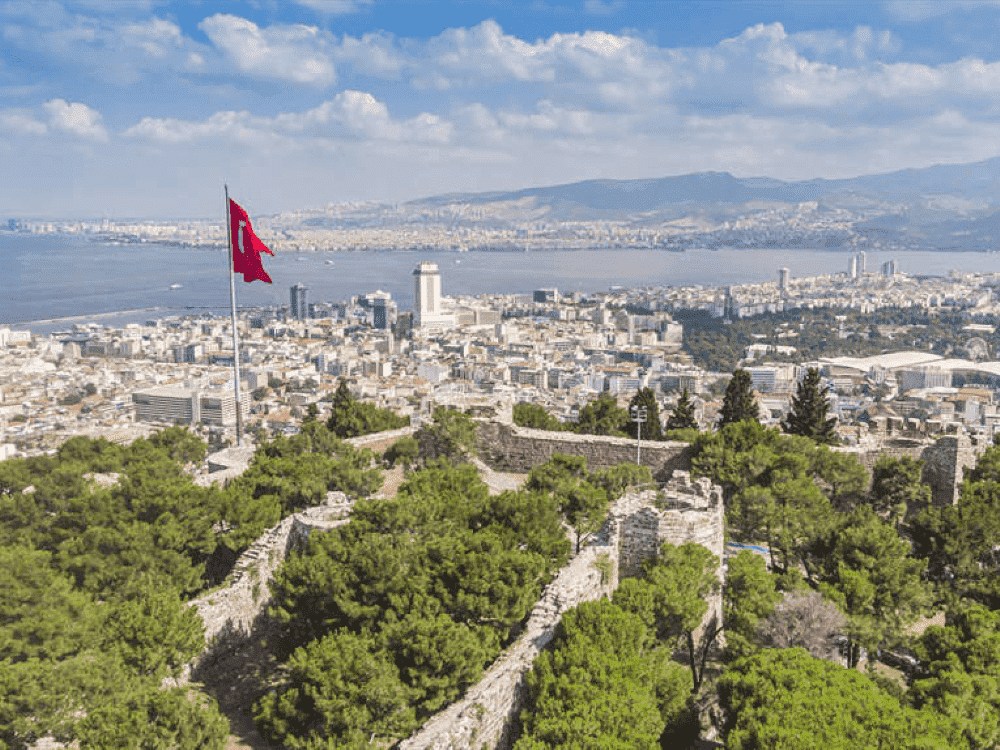Located on Mount Pagos at an altitude of 186 meters in the south of İzmir, Velvet Castle (Kadifekale) is a part of a rich heritage that stretches from antiquity to the present day. As part of the city that was re-established in the 4th century BC after the destruction of ancient Smyrna, Velvet Castle stands out as a multi-layered historical site with remnants from the Hellenistic, Roman, Byzantine, and Ottoman periods. Commissioned by Lysimachus, one of Alexander the Great’s generals, the castle became one of the key elements of the city’s defense system thanks to its strategic location and architectural features.

Velvet Castle (İzmir Art)
Historical Development and Foundation
The origins of Velvet Castle date back to the 4th century BC, when the ancient city of Smyrna was reestablished around Mount Pagos. Following Alexander the Great’s liberation of Anatolia from Persian rule in 334 BC, the city was replanned and relocated to the slopes of Pagos, and the castle was built as part of this new settlement. Ancient sources indicate that the fortress was commissioned by Lysimachus, one of Alexander’s generals. Although some sources claim that Pagos was previously a Leleg settlement, no archaeological evidence has yet been found to support this assertion.
From its foundation onward, the castle functioned as a vital part of Smyrna’s defense system. Due to İzmir’s exposure to various attacks throughout history, the city had to be fortified, and Velvet Castle became the centerpiece of this defense network. In antiquity, two walls extended from the castle—one toward the road to Sardis in today’s Basmane, and the other toward the road to Ephesus in the Eşrefpaşa area. These walls were intended to safeguard the city’s land and sea connections. Built during the Hellenistic period, the castle continued to be used and reinforced in the Roman era. However, in the post-Roman period, especially during the Middle Ages, the fortress suffered significant destruction. In 1402, it was severely damaged during the attacks of Timur’s armies, and later in 1668, a major earthquake in İzmir caused further devastation.
During the Byzantine period, the castle maintained its strategic importance, with additions such as cisterns constructed to secure water supply. In the Ottoman era, however, the fortress largely lost its military function and was gradually abandoned. Travelers visiting İzmir in the 19th century reported that much of the structure had disappeared. According to Ottoman sources, parts of the walls were demolished by Sultan Mehmed Çelebi, which contributed to the limited remains that have survived to the present day.

Architectural Features and Remains
Velvet Castle is a defensive structure situated atop Mount Pagos at an elevation of 186 meters, covering an area of approximately 6 kilometers. The castle was constructed using rubble stone, cut stone, and brick—materials that reflect the architectural techniques and use of local resources of its era. The surviving remains are mostly limited to five towers on the western side and a section of the southern walls. These towers, ranging in height from 20 to 35 meters, are notable elements supporting the original structure of the walls. The eastern and northern parts of the castle, however, have been completely destroyed.
Among the most significant structures within the castle are a Byzantine-era arched cistern and the remains of a small mosque (mescit). The cistern, made of rubble and brick, is covered with soil fill. Its interior is divided into sections by rounded brick arches resting on pillars. Excavations carried out in the second half of the 20th century helped bring the cistern to light in relatively good condition. Designed to meet the city’s water needs, it exemplifies practical solutions in Byzantine architecture. The mosque remains, dating to the Ottoman period, offer clues about the site's use during the Turkish-Islamic era. Additionally, there are remnants of a passageway (or corridor) inside the castle, though its function and exact dating remain unclear.
The fortress walls bear traces of the Hellenistic and Roman periods. Research beneath the medieval walls has revealed remains dating back to the Hellenistic period (330 BCE–20 CE). These findings highlight the site’s multi-layered architectural past. On the eastern side, rectangular stone blocks (large-cut stones) still remain visible at the beginning of the road stretching from Basmane Station to Tilkilik and Altınpark. These stones reflect both the durability and aesthetic value of the materials used in the castle’s original construction.
Velvet Castle’s architectural design is well-aligned with its strategic location. Overlooking the Gulf of İzmir, the castle served both defensive and surveillance purposes. Its 6-kilometer perimeter protected a wide area of the city, while the tall towers offered clear views to monitor enemy movement. However, over time, natural disasters and human activity have destroyed much of the structure.
Archaeological Research and Findings
Systematic archaeological excavations at Velvet Castle intensified in the second half of the 20th century. These excavations were particularly effective in uncovering the cistern and sections of the fortress walls. The discovery of Hellenistic-period wall remains confirms that the first settlements within the castle date back to the 4th century BCE. Traces from the Roman period are associated with the reinforcement of the walls and the expansion of internal structures. The Byzantine cisterns demonstrate the sophistication of the water management systems, while the Ottoman mosque remains provide evidence of the site's use during the Turkish-Islamic period.
However, a comprehensive inventory of archaeological finds at Velvet Castle has not yet been established. The lack of concrete evidence supporting ancient sources that mention a Leleg settlement makes it difficult to verify such claims. Nonetheless, the Hellenistic and Roman remains shed light on the period following the reestablishment of Smyrna. Reports by 19th-century travelers already indicate that the castle was largely in ruins, which may explain the limitations of archaeological studies in the area.
Current Status and Tourism Initiatives
Today, Velvet Castle is considered one of İzmir’s significant tourist attractions, offering panoramic views of the city. However, due to the ruinous condition of much of the structure, restoration and revitalization efforts are needed to fully realize its touristic potential. İzmir Metropolitan Municipality is carrying out various projects in this regard, including landscaping and cultural activities aimed at integrating the site into tourism.
One such initiative is the Pagos Producers' Market, held every Saturday at Velvet Castle. This market, where women’s cooperatives sell their products, not only supports the local economy but also transforms the site into a social meeting point. Musical performances during the market enhance its appeal to visitors. Furthermore, infrastructure improvements and lighting systems around the castle now allow for night visits, increasing its visibility in the city’s silhouette.
Despite its historical significance, the current physical representation of Velvet Castle is limited to the five towers on the west and parts of the southern walls. While these remnants may not fully reflect the castle’s past grandeur, they are valuable sources for understanding the city's layered history. Its commanding position over the Gulf of İzmir renders the fortress historically and touristically significant.
Cultural and Strategic Importance
Since the reestablishment of ancient Smyrna, Velvet Castle has been one of the cornerstones of the city’s defense and administrative systems. Built by Lysimachus as a legacy of Alexander the Great, the castle ensured the city’s security during the Hellenistic period and continued to fulfill this role under Roman rule. Throughout the Byzantine and Ottoman eras, the structure was repurposed for different functions but always retained its strategic value. Myths associating Mount Pagos with Amazon women add a mythical dimension to the castle, although these tales are not supported by archaeological data.
The castle’s 6-kilometer perimeter and tall towers demonstrate its capacity to control a large area in antiquity. The walls connecting the city to the sea helped Smyrna become a strategic commercial and military hub. Despite the damage caused by medieval destruction and earthquakes, Velvet Castle’s historical importance has not diminished. Today, the castle serves as an open-air museum of İzmir’s past, presenting the Hellenistic, Roman, Byzantine, and Ottoman layers of the city’s history in one place.
In terms of tourism, Velvet Castle's full potential has yet to be realized. Although the municipality’s projects aim to turn the site into a cultural hub, it is clear that restoration and excavation efforts need to be expanded. With its breathtaking view of the bay and events like the Pagos Producers' Market, the site plays an important role in promoting local culture and providing visitors with a unique experience.


